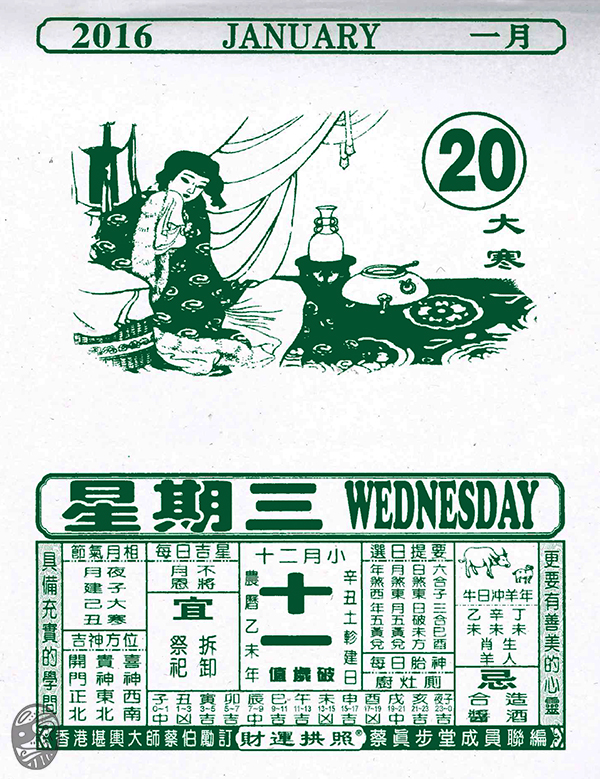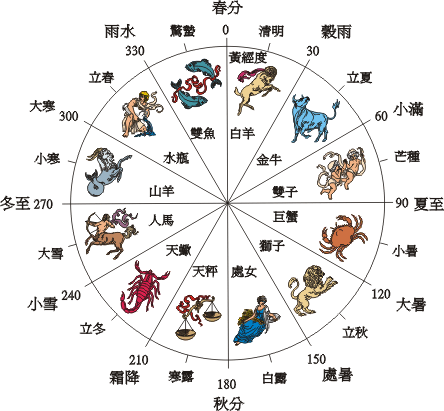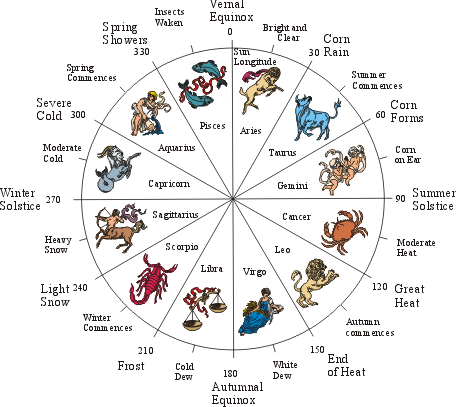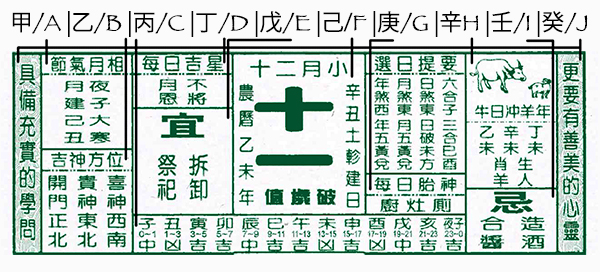
相片:在下家鄉傳統的農曆日曆 -
是日為農曆乙未年己丑(十二)月辛丑(十一)日,公曆二零一六年一月廿日,及本年最後一個節氣 - 「大寒」。
Photo: tRADITIONAL dAILY aGRICULTURAL cALENDAR (also called as lUNAR calendar) from my hOME –
tODAY is: the 11th day of the 12th month of the 32th year Yiwei (traditional Agricultural calendar), 20th of January 2016 (gREGORIAN calendar), and the lAST sOLAR tERM of the year – “sEVERE cOLD”.
***
曆|cALENDAR
有朋友問道:「為什麼《除夜》一詩中會提到春天?」
A friend asked: “Why is the ‘sPRING’ mentioned in the poem ‘Old Year’s Day‘?”
這可要從我們的曆法說起。
Then let’s begin with our calendar.
曆
Calendar
華夏文化有自己的一套曆法-傳統農曆。
The Great Chinese culture has its own set of calendar – traditional Agricultural calendar.
歷史上記載,相傳黃帝(公元前二六九八年-二五九八年)制定了曆法,是現今傳統農曆的原形。古時,人民主要以務農為生,而為求生活平安順利,人民需要一套有用的曆法。因此,傳統的華夏曆法不只是計算日子,還可以提供天文、氣象、地理及風水等重要的科學資訊。同時,在這數千年間,歷代創造了超過一百部曆法,並經過不斷的改良、修正及薪傳,傳統農曆至今仍被重視及應用於生活之中。
According to the historical records and the legend, the Yellow Emperor (2698-2598 BC) invented calendar, which is the prototype of today’s traditional Agricultural calendar. In the ancient time, people mainly lived by farming, and in order to live safely and smoothly, people need a useful calendar. Therefore, the traditional Agricultural calendar is not just counting the days, also offers astronomical, meteorological, geographical and geomantic etc. important scientific information. Moreover, the past dynasties had created more than hundred sets of calendars in the thousands of years, and by continuously improving, correcting and passing on, the traditional Agricultural calendar is still respected and applied to life.
傳統農曆
The traditional Agricultural calendar
傳統農曆是由陰曆跟陽曆結合而成,為陰陽曆。
The traditional Agricultural calendar is a combination of Lunar calendar and Solar calendar, it’s a lUNISOLAR calendar.
陰曆,是以月亮的周期性變化而編制,從一滿月至下一滿月為一周期為一周期(朔望月)。因月相天象明顯,容易紀錄,用以紀年(月、日)。同時,人們能單憑自然天象便知道日子,例如每月的第一日必定是「新月」,第十五日必定是「滿月」。但是,陰曆不能反映季節的變化及其周期長度(小月廿九天,大月三十天)較地球實際公轉時間短約十至十一日。
Lunar calendar is created based on the cyclical changes of phases of the Moon, from one New Moon to the next New Moon is a cycle (“Synodic month”). As the phenomenon of the Moon’s phases are so clear and easy to be recorded, so people use this Lunar calendar for counting days. Also people can easily know the date by observing the natural astronomical phenomenon, e.g. the first day of every month must be “new moon”, and the 15th day of every month must be “Full Moon”. However, Lunar calendar can not reflect the changes of seasons and its length of the cycle (29 days for short month, 30 days for long month) is around 10-11 days shorter than the actual length of the cycle of the Earth’s revolution.
陽曆,是以太陽的周期性變化而編制,從一春天至下一春天為一周期(回歸年),概念跟西方的格里曆(公曆)相似。同時,陽曆會再細分*「廿四節氣」以反映季節之變化,有助農務,但不作紀日。加上,其周期長度較地球實際公轉時間差異較短,相對較易以閏年來調整。
Solar calendar is created based on the Earth’s revolution around the Sun, from one Spring to the next Spring is a cycle, also means the time of the return of the Sun’s position along the Ecliptic (“Tropical year”), its concept is similar to Gregorian calendar. Furthermore, the Solar calendar is divided into “24 solar term”, with 15 degrees of the Sun’s longitude between each term. It reflects the changes of the seasons and helps farming, but no function to count days. Plus, there’s smaller difference between its length of cycle and the length of the Earth’s revolution, that can be solved easily by adjusting to be leap year.
「春」
“Spring”
華夏文化,以春為始,惟農曆以陰曆作紀日,較公曆的周期長度短。所以,經計算後,華人的農曆新年通常會被編定於相等公曆的一月至二月之間,年年不一。
In Great Chinese culture, year starts in Spring, but because we use the Lunar calendar for counting days, which is shorter than the length of the Gregorian calendar’s cycle. Therefore, our Lunar New Year normally will be scheduled equally to the Gregorian calendar between January to February after calculation, and every year is different.
*以下為香港天文台的「廿四節氣跟黃道十二宮」圖表:

*Below is the figure from The Hong Kong Observatory about “The 24 solar terms and the 12 zodiac constellations”:

(香港天文台註:「十二星座對應的黃經度是在二千多年前定下的,由於地球自轉軸的擺動,現在觀測到的星座位置與黃經度已不符。」。另,有關更多「廿四節氣」或其他相關基本資料如「農曆曆法」、「天干和地支」、「十二生肖」及「公曆與農曆對照表」等,可參訪香港天文台網站。)
(The Hong Kong Observatory’s remarks: “The determination of the 12 zodiac constellations according to the Sun’s longitude was made more than 2000 years ago. Due to precession of the Earth’s rotation axis, the positions of the constellations as observed nowadays have already shifted to other longitudes.” Besides, you can get more basic information about “The 24 solar terms” or other related, such as “The Chinese Agricultural Calendar, “Heavenly Stems and Earthly Branches”, “The 12-Year Animal Cycle” and “Gregorian-Lunar Calendar Conversion Table” etc. by visiting The Hong Kong Observatory’s website.)
傳統農曆和公曆
The traditional Agricultural calendar and the Gregorian calendar
以前,華人社會一直只使用傳統農曆。直至一九一二年,當時的中華民國臨時政府-臨時大總統孫中山先生宣布改用公曆為國曆。然而,傳統農曆沒有完全被取代和仍被人民需要,尤其涉及農務、節慶、壽慶、嫁娶、命名或風水等跟生活息息相關的東西。
In the past, the Chinese community had been using the traditional Agricultural calendar only. Until 1912, Sun Yat-sen (also as Sūn Zhongshan/ Sun Wen or Sun Deming), the Provisional President of Provisional Government of the Republic of China, announced the changing of state’s calendar by adopting the Gregorian calendar. However, the traditional Agricultural calendar has not been completely replaced and it is still the people’s needs, especially when the daily lives are related to farming, festival/Solar term celebrations, birthday celebrations, marriage, naming or Feng Shui and so on.
最後
At last
於在下,華夏的傳統農曆,是有著無價的文化及學術價值,值得珍惜。
To me, the traditional Agricultural calendar is of priceless cultural and academic values, it’s worth to cherish.
***
補充資料
Additional information
***
十分簡之農曆日曆資訊簡介:
Very simple introduction about the contents of the daily Agricultural calendar:

甲、節氣月相
A. Solar Term and the phenomenon of the Moon’s phases
乙、吉神方位
B. Cardinal directions of Lucky gods
丙、是日吉凶時辰
C. Lucky and cursed hours of the day
丁、每日吉星
D. Today’s Lucky Star
戊、是日宜⋯
E. Today is suitable/good for…
己、是日詳述
F. Details of today (Agricultural calendar)
庚、每日胎神方位
G. Today’s cardinal direction of the Fetal God
辛、生肖屬羊的人跟生肖屬牛的人不合
G. People with Zodiac-Goat and the people with Zodiac-Ox will clash
壬、是日忌諱
I. Taboos of the day
癸、心靈提示-
J. Mind Tips –
「具備充實的學問,更要有善美的心靈。」
“One has Wisdom, should also have a beautiful kind Heart.”
註:
nOTE:
在下較喜歡兒時的日曆,每日印有一古詩,如唐詩,更有趣。
I like my childhood calendar more, because it’s printed with everyday ancient poem, e.g. poems from Tang Dynasty (618–907), that’s more interesting.
..,
It’s goin too bbe finish oof mine day, hoever
before endin I amm readinng thios wonderful article tto ikprove my experience.
Wow! After all I got a webpage from wyere I know
how to genuinely get helpful facts concerning my study and
knowledge. https://glassi-Greyhounds.mystrikingly.com/
Hello, i think that i saw you visited my website thus i
came to “return the favor”.I’m attempting to
find things to enhance my website!I suppose its ok to usse a few of your ideas!! https://Ariaqa.com/employer/tonebet-casino/
I don’t even understand how I enhded uup here, but I thought this publish waas great.
I do not know who you might be but certainly you are going
to a well-known blogger for those who aren’t already.
Cheers! https://caramellaapp.com/milanmu1/xBmcpzJ0b/retired-players